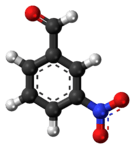3-Nitrobenzaldehyde
| |||
| Names | |||
|---|---|---|---|
| IUPAC name
3-Nitrobenzaldehyde | |||
| Other names
m-Nitrobenzaldehyde | |||
| Properties | |||
| C7H5NO3 | |||
| Molar mass | 151.12 g·mol−1 | ||
| Appearance | Yellowish to brownish crystalline powder or granulate | ||
| Melting point | 58.5 °C (137.3 °F; 331.6 K) | ||
| Boiling point | 164 °C (327 °F; 437 K) at 23 mmHg | ||
| 16.3 mg/mL | |||
| Identifiers | |||
| 99-61-6 | |||
| 3D model (Jmol) | Interactive image | ||
| ChEMBL | ChEMBL238132 | ||
| ChemSpider | 7169 | ||
| ECHA InfoCard | 100.002.520 | ||
| PubChem | 7449 | ||
| |||
| |||
| Hazards | |||
| Main hazards | Harmful,Potentially mutagenic | ||
| R-phrases | R20 R21 R22 | ||
| S-phrases | S26 S28 | ||
| NFPA 704 | |||
| Except where otherwise noted, data are given for materials in their standard state (at 25 °C [77 °F], 100 kPa). | |||
| | |||
| Infobox references | |||
3-Nitrobenzaldehyde, meta-nitrobenzaldehyde or m-nitrobenzaldehyde is an organic aromatic compound containing a nitro group meta-substituted to an aldehyde. 3-Nitrobenzaldehyde is the primary product obtained via the mono-nitration of benzaldehyde with nitric acid.
Synthesis
The synthesis of 3-nitrobenzaldehyde is accomplished via nitration of benzaldehyde, which yields mostly the meta-isomer. Product distribution is about 19% for the ortho-, 72% for the meta- and 9% for the para isomers.[3]
Uses
A known use of 3-Nitrobenzaldehyde is in the synthesis of Tipranavir.
References
- ↑ 3-Nitrobenzaldehyde
- ↑ 3-Nitrobenzaldehyde MSDS
- ↑ Structure of Benzene, California State University Dominguez Hills
This article is issued from Wikipedia - version of the 7/29/2016. The text is available under the Creative Commons Attribution/Share Alike but additional terms may apply for the media files.


